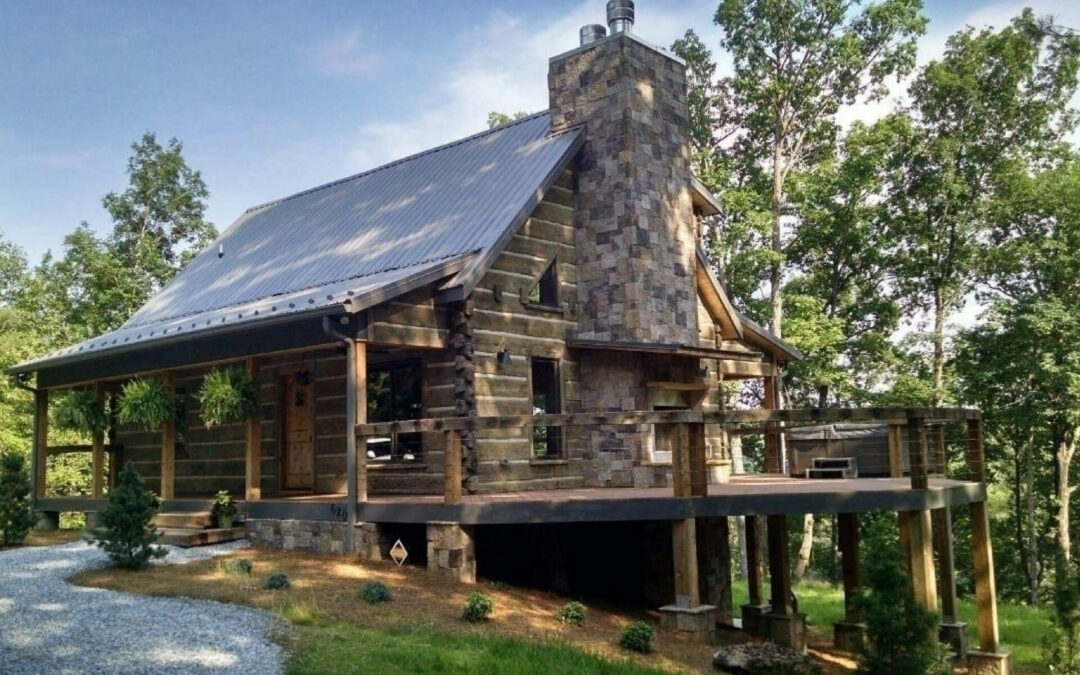Building a log cabin is a dream for many, and understanding the basics of log cabin construction is essential to ensure a successful project. Choosing the right materials is crucial, as they play a significant role in the durability and overall quality of the cabin. In Wilmington, there are several options available when it comes to log cabin building materials.
Understanding the Basics of Log Cabin Construction
Before delving into the specifics of materials, it is important to have a solid understanding of the key elements involved in log cabin construction. Log cabins are built using interlocking logs, which provide structural integrity and aesthetic appeal. These logs can be stacked horizontally or vertically, depending on the desired design.
The corners of log cabins are typically notched, which enhances the stability of the structure. This intricate technique requires precision and expertise to ensure a tight fit and prevent gaps. The notching process can vary based on the specific log cabin design and the materials used.
The Importance of Choosing Quality Materials
When it comes to log cabin construction, the quality of the materials used is of utmost importance. Choosing high-quality materials ensures the longevity and structural integrity of the cabin. Additionally, premium materials enhance the overall aesthetic appeal and add value to the property.
Investing in quality materials may initially incur a higher cost, but it pays off in the long run. High-quality materials are more durable and require less maintenance, saving you both time and money in the future. When selecting log cabin building materials, prioritize longevity and durability over short-term cost savings.
Key Elements in Log Cabin Building
In addition to the logs themselves, there are several other key elements to consider when building a log cabin. These elements include the foundation, insulation, roofing, and flooring. Each of these components contributes to the overall strength and functionality of the cabin.
The foundation provides stability and prevents shifting or settling of the structure. Various foundation options, such as concrete or pier and beam, are available depending on the specific site conditions and preferences.
Insulation is crucial in log cabins, as it helps regulate temperature and improve energy efficiency. Proper insulation ensures a comfortable living environment throughout the year, regardless of external weather conditions.
Roofing is another critical aspect of log cabin construction. It protects the cabin from weather elements, such as rain, snow, and UV rays. The choice of roofing material should take into account factors such as durability, maintenance requirements, and aesthetic appeal.
The flooring in a log cabin should be able to withstand heavy foot traffic and provide comfort underfoot. Wooden flooring is a popular choice due to its durability, natural beauty, and ability to enhance the rustic charm of log cabins.
Types of Wood Used in Wilmington Log Cabins
Wood is the primary material used in log cabin construction, and there are several types commonly used in Wilmington. Each type has its own unique characteristics, making it suitable for different applications.
Pine: A Popular Choice for Log Cabins
Pine is a popular choice for log cabins due to its affordability and accessibility. It is a softwood that is readily available in the Wilmington area. Pine logs are relatively lightweight, making them easier to handle during construction. However, pine may require additional maintenance and protection to prevent rot and insect infestation.
Despite these considerations, pine logs provide a traditional, rustic look and blend seamlessly with natural surroundings. Many log cabin enthusiasts appreciate the warm, golden hue of pine, which adds character and charm to the cabin.
Cedar: The Premium Option for Durability
For those seeking unparalleled durability and natural resistance to weathering, cedar is an excellent choice for log cabin construction. Cedar logs are known for their exceptional strength and resistance to decay and insect damage. This premium wood option requires minimal maintenance and is highly sought after for its longevity.
Cedar provides a distinctive reddish-brown color, which gradually weathers to an attractive silvery-gray patina over time. This aging process adds to the rustic charm of log cabins and contributes to their timeless appeal.
Oak: A Classic Choice for Log Cabins
Oak is a classic choice for log cabins, known for its strength, durability, and prominent grain pattern. Oak logs are heavy, sturdy, and provide excellent structural support. The natural beauty of oak adds elegance and sophistication to log cabins, making them stand out amidst their surroundings.
While oak is a premium wood option, it requires careful maintenance to prevent moisture-related issues. Proper sealing and protection are necessary to ensure its long-term performance.
Evaluating the Best Insulation Materials
Insulation is a crucial element in log cabin construction, as it helps maintain a comfortable indoor environment and improves energy efficiency. Two popular insulation options for log cabins are batt insulation and spray foam insulation.
Batt Insulation for Log Cabins
Batt insulation, also known as blanket insulation, consists of fiberglass or mineral wool. It is available in pre-cut rolls or blankets, making it easy to install in log cabins. Batt insulation is an affordable option that provides effective thermal resistance.
However, it is important to ensure proper installation, as any gaps or compression can compromise its performance. Additionally, batt insulation may not be suitable for areas with moisture concerns, as it can absorb and retain water.
Spray Foam Insulation: Pros and Cons
Spray foam insulation is a popular choice for log cabins due to its excellent insulating properties and ability to seal gaps effectively. It is applied as a liquid, expanding to fill all crevices and forming a continuous barrier against air leakage.
One of the key advantages of spray foam insulation is its superior insulation performance, which helps reduce energy consumption and costs. It also offers soundproofing capabilities, enhancing the overall comfort of the log cabin.
However, it is important to consider the potential health and environmental concerns associated with spray foam insulation. Some formulations may emit volatile organic compounds (VOCs) during installation. Proper ventilation and choosing low-VOC options can mitigate these risks.
Selecting the Right Roofing Materials
Roofing materials play a crucial role in protecting log cabins from the elements, so it is important to choose the right option for Wilmington’s climate. Two common roofing materials used in log cabin construction are metal roofing and asphalt shingles.
Metal Roofing for Log Cabins
Metal roofing offers durability, longevity, and resistance to extreme weather conditions. It is highly durable, capable of withstanding heavy winds, hail, and even fire. Metal roofing requires minimal maintenance and is an excellent long-term investment.
Additionally, metal roofing is available in a variety of styles and colors, allowing log cabin owners to achieve their desired aesthetic. Whether aiming for a rustic or contemporary look, metal roofing offers versatility in design.
Asphalt Shingles: A Cost-Effective Option
Asphalt shingles are a popular and cost-effective choice for log cabins. They come in a range of colors and styles, allowing for customization. Asphalt shingles are easy to install and require minimal maintenance.
While asphalt shingles provide adequate protection, they may have a shorter lifespan compared to metal roofing. Regular inspection and maintenance can help prolong their durability and ensure their long-term performance.
Choosing the Best Flooring for Your Log Cabin
The choice of flooring significantly impacts the overall look and feel of a log cabin. There are various flooring options available, each with its own unique features and benefits.
Hardwood Flooring: A Natural Fit for Log Cabins
Hardwood flooring is a popular choice for log cabins due to its durability, timeless appeal, and ability to withstand heavy use. Hardwood floors provide natural beauty and a warm, rustic ambiance that complements log cabin aesthetics.
There are various hardwood species to choose from, including oak, hickory, and maple. Each species has its distinct grain patterns and color variations, allowing log cabin owners to achieve their desired look.
Laminate Flooring: A Budget-Friendly Alternative
If you are looking for a budget-friendly flooring option, laminate flooring is worth considering. It mimics the look of hardwood flooring but at a more affordable price point. Laminate flooring is durable, scratch-resistant, and easy to maintain.
With advancements in technology, laminate flooring now comes in a wide range of designs, imitating various wood species and even stone. This versatility allows log cabin owners to achieve the desired aesthetic without compromising on quality or budget.
In conclusion, when it comes to log cabin building materials in Wilmington, understanding the basics of log cabin construction is crucial. Choosing quality materials, such as pine, cedar, or oak, ensures durability and adds value to the cabin. Considering insulation options like batt insulation or spray foam insulation helps maintain a comfortable indoor environment. Selecting the right roofing materials, such as metal roofing or asphalt shingles, protects the log cabin from the elements. Lastly, choosing hardwood or laminate flooring complements the overall aesthetic of the log cabin while providing durability and functionality.
Discover the Smart Alternative with Smart Logs Of The Carolinas
Ready to build your dream log cabin with materials that redefine durability and efficiency? Smart Logs of the Carolinas offers concrete logs that not only capture the authentic beauty of traditional wood but also provide unparalleled resistance to the elements and pests. Embrace the environmentally friendly choice that’s fire resistant, simple to install, and designed to preserve natural resources. With Smart Logs, you’ll enjoy a low-maintenance cabin that’s energy efficient and cost-effective in the long run. Don’t settle for less—upgrade your log cabin experience and save on insurance, installation, and maintenance costs. Contact Us! today to learn more about how Smart Logs of the Carolinas can make your log cabin vision a reality.

